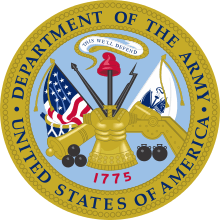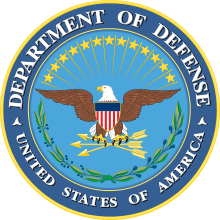United States Army
The United States Army (USA) is the largest branch of the United States Armed Forces and performs land-based military operations. It is one of the seven uniformed services of the United States and is designated as the Army of the United States in the United States Constitution, Article 2, Section 2, Clause 1 and United States Code, Title 10, Subtitle B, Chapter 301, Section 3001. As the largest and senior branch of the U.S. military, the modern U.S. Army has its roots in the Continental Army, which was formed (14 June 1775) to fight the American Revolutionary War (1775–1783)—before the U.S. was established as a country.[6] After the Revolutionary War, the Congress of the Confederation created the United States Army on 3 June 1784, to replace the disbanded Continental Army.[7][8] The United States Army considers itself descended from the Continental Army, and dates its institutional inception from the origin of that armed force in 1775.[6]
As a uniformed military service, the Army is part of the Department of the Army, which is one of the three military departments of the Department of Defense. The U.S. Army is headed by a civilian senior appointed civil servant, the Secretary of the Army (SECARMY), and by a chief military officer, the Chief of Staff of the Army (CSA) who is also a member of the Joint Chiefs of Staff. In the fiscal year 2017, the projected end strength for the Regular Army (USA) was 460,000 soldiers; the Army National Guard (ARNG) had 335,000 soldiers, and the United States Army Reserve (USAR) had 195,000 soldiers; the combined-component strength of the U.S. Army was 990,000 soldiers.[3] As a branch of the armed forces, the mission of the U.S. Army is "to fight and win our Nation's wars, by providing prompt, sustained, land dominance, across the full range of military operations and the spectrum of conflict, in support of combatant commanders."[9] The service participates in conflicts worldwide and is the major ground-based offensive and defensive force.
Mission
The United States Army serves as the land-based branch of the U.S. Armed Forces. Section 3062 of Title 10 US Code defines the purpose of the army as:[10][11]
- Preserving the peace and security and providing for the defense of the United States, the Commonwealths and possessions and any areas occupied by the United States
- Supporting the national policies
- Implementing the national objectives
- Overcoming any nations responsible for aggressive acts that imperil the peace and security of the United States
History
Origins

The Continental Army was created on 14 June 1775 by the Continental Congress[12] as a unified army for the colonies to fight Great Britain, with George Washington appointed as its commander.[6][13][14][15] The army was initially led by men who had served in the British Army or colonial militias and who brought much of British military heritage with them. As the Revolutionary War progressed, French aid, resources, and military thinking influenced the new army. A number of European soldiers came on their own to help, such as Friedrich Wilhelm von Steuben, who taught the army Prussian tactics and organizational skills.
The army fought numerous pitched battles and in the South 1780–81 sometimes used the Fabian strategy and hit-and-run tactics, hitting where the enemy was weakest, to wear down the British forces. Washington led victories against the British at Trenton and Princeton, but lost a series of battles around New York City in 1776 and Philadelphia in 1777. With a decisive victory at Yorktown, and the help of the French, the Continental Army prevailed against the British.
After the war, though, the Continental Army was quickly given land certificates and disbanded in a reflection of the republican distrust of standing armies. State militias became the new nation's sole ground army, with the exception of a regiment to guard the Western Frontier and one battery of artillery guarding West Point's arsenal. However, because of continuing conflict with Native Americans, it was soon realized that it was necessary to field a trained standing army. The Regular Army was at first very small, and after General St. Clair's defeat at the Battle of the Wabash, the Regular Army was reorganized as the Legion of the United States, which was established in 1791 and renamed the "United States Army" in 1796.
19th century
Early Wars on the Frontier
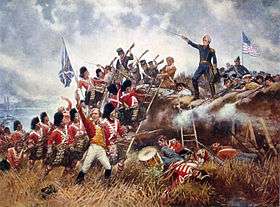
The War of 1812, the second and last American war against Great Britain was a mixed success. The Army did not conquer Canada but it did destroy the Indian threat to expansion in the Midwest, and it validated American independence by stopping two major British invasions in 1814 and 1815. After the taking control of Lake Erie in 1813, the Americans were able to seize parts of western Upper Canada, burn York and defeat Tecumseh, which caused his Indian Confederacy to collapse. Following ending American victories in the Canadian province of Upper Canada, which dubbed the U.S. Army "Regulars, by God!", British troops were able to capture and burn Washington in 1814, which was defended by militia. The regular army, however, proved they were professional and capable of defeating the British army during the invasions of Plattsburgh and Baltimore, prompting British agreement on the previously rejected terms of a status quo ante bellum. Two weeks after a treaty was signed (but not ratified), Andrew Jackson defeated the British in the Battle of New Orleans and Siege of Fort St. Philip, and became a national hero. Little less known due to the intensity of the battles, U.S. troops and sailors captured HMS Cyane, Levant, and Penguin in the final engagements of the war. Per the treaty, both sides, the United States and Great Britain, returned to the geographical status quo. Warships, however, were never returned to the nation captured from.
The army's major campaign against the Indians was fought in Florida against Seminoles. It took long wars (1818–58) to finally defeat the Seminoles and move them to Oklahoma. The usual strategy in Indian wars was to seize control of the Indians' winter food supply, but that was no use in Florida where there was no winter. The second strategy was to form alliances with other Indian tribes, but that too was useless because the Seminoles had destroyed all the other Indians when they entered Florida in the late eighteenth century.[16]
The U.S. Army fought and won the Mexican–American War (1846–1848), which was a defining event for both countries.[17] The U.S. victory resulted in acquisition of territory that eventually became all or parts of the states of California, Nevada, Utah, Colorado, Arizona, Wyoming and New Mexico.
American Civil War

The American Civil War was the costliest war for the U.S. in terms of casualties. After most slave states, located in the southern U.S., formed the Confederate States, C.S. troops led by former U.S. Army officers, mobilized a very large fraction of Southern white manpower. Forces of the United States (the "Union" or "the North") formed the Union Army consisting of a small body of regular army units and a large body of volunteer units raised from every state, north and south, except South Carolina.[18]
For the first two years Confederate forces did well in set battles but lost control of the border states.[19] The Confederates had the advantage of defending a very large country in an area where disease caused twice as many deaths as combat. The Union pursued a strategy of seizing the coastline, blockading the ports, and taking control of the river systems. By 1863 the Confederacy was being strangled. Its eastern armies fought well, but the western armies were defeated one after another until the Union forces captured New Orleans in 1862 along with the Tennessee River. In the famous Vicksburg Campaign of 1862–63, Ulysses Grant seized the Mississippi River and cut off the Southwest. Grant took command of Union forces in 1864 and after a series of battles with very heavy casualties, he had Lee under siege in Richmond as William T. Sherman captured Atlanta and marched through Georgia and the Carolinas. The Confederate capital was abandoned in April 1865 and Lee subsequently surrendered his army at Appomattox Court House; all other Confederate armies surrendered within a few months.
The war remains the deadliest conflict in American history, resulting in the deaths of 620,000 soldiers. Based on 1860 census figures, 8% of all white males aged 13 to 43 died in the war, including 6.4% in the North and 18% in the South.[20]
Later 19th century
Following the Civil War, the U.S. Army had the mission of containing western tribes of Native Americans on their reservations. There were many forts set up, and several campaigns. U.S. Army troops also occupied several Southern states during the Reconstruction Era to protect freedmen.
The key battles of the Spanish–American War of 1898 were fought by the Navy. Using mostly new volunteers, the U.S. Army defeated Spain in land campaigns in Cuba and played the central role in suppressing a rebellion in the Philippines.
20th century

Starting in 1910, the army began acquiring fixed-wing aircraft.[21] In 1910, Mexico was having a civil war, peasant rebels fighting government soldiers. The army was deployed to American towns near the border to ensure safety to lives and property. In 1916, Pancho Villa, a major rebel leader, attacked Columbus, New Mexico, prompting a U.S. intervention in Mexico until 7 February 1917. They fought the rebels and the Mexican federal troops until 1918. The United States joined World War I in 1917 on the side of Britain, France, Russia, Italy and other allies. U.S. troops were sent to the Western Front and were involved in the last offensives that ended the war. With the armistice in November 1918, the army once again decreased its forces.
_March_1944.jpg)
The United States joined World War II in December 1941 after the Japanese attack on Pearl Harbor. On the European front, U.S. Army troops formed a significant portion of the forces that captured North Africa and Sicily, and later fought in Italy. On D-Day, June 6, 1944, and in the subsequent liberation of Europe and defeat of Nazi Germany, millions of U.S. Army troops played a central role. In the Pacific War, U.S. Army soldiers participated alongside the United States Marine Corps in capturing the Pacific Islands from Japanese control. Following the Axis surrenders in May (Germany) and August (Japan) of 1945, army troops were deployed to Japan and Germany to occupy the two defeated nations. Two years after World War II, the Army Air Forces separated from the army to become the United States Air Force in September 1947 after decades of attempting to separate. Also, in 1948, the army was desegregated by order of President Harry S. Truman.
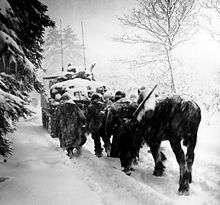
The end of World War II set the stage for the East–West confrontation known as the Cold War. With the outbreak of the Korean War, concerns over the defense of Western Europe rose. Two corps, V and VII, were reactivated under Seventh United States Army in 1950 and American strength in Europe rose from one division to four. Hundreds of thousands of U.S. troops remained stationed in West Germany, with others in Belgium, the Netherlands and the United Kingdom, until the 1990s in anticipation of a possible Soviet attack.
_003.jpg)
During the Cold War, American troops and their allies fought Communist forces in Korea and Vietnam. The Korean War began in 1950, when the Soviets walked out of a U.N. Security meeting, removing their possible veto. Under a United Nations umbrella, hundreds of thousands of U.S. troops fought to prevent the takeover of South Korea by North Korea, and later, to invade the northern nation. After repeated advances and retreats by both sides, and the PRC People's Volunteer Army's entry into the war, the Korean Armistice Agreement returned the peninsula to the status quo in 1953.
The Vietnam War is often regarded as a low point for the U.S. Army due to the use of drafted personnel, the unpopularity of the war with the American public, and frustrating restrictions placed on the military by American political leaders. While American forces had been stationed in the Republic of Vietnam since 1959, in intelligence & advising/training roles, they were not deployed in large numbers until 1965, after the Gulf of Tonkin Incident. American forces effectively established and maintained control of the "traditional" battlefield, however they struggled to counter the guerrilla hit and run tactics of the communist Viet Cong and the North Vietnamese Army. On a tactical level, American soldiers (and the U.S. military as a whole) did not lose a sizable battle.[22]
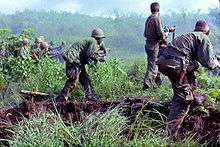
During the 1960s the Department of Defense continued to scrutinize the reserve forces and to question the number of divisions and brigades as well as the redundancy of maintaining two reserve components, the Army National Guard and the Army Reserve.[23] In 1967 Secretary of Defense Robert McNamara decided that 15 combat divisions in the Army National Guard were unnecessary and cut the number to 8 divisions (1 mechanized infantry, 2 armored, and 5 infantry), but increased the number of brigades from 7 to 18 (1 airborne, 1 armored, 2 mechanized infantry, and 14 infantry). The loss of the divisions did not set well with the states. Their objections included the inadequate maneuver element mix for those that remained and the end to the practice of rotating divisional commands among the states that supported them. Under the proposal, the remaining division commanders were to reside in the state of the division base. No reduction, however, in total Army National Guard strength was to take place, which convinced the governors to accept the plan. The states reorganized their forces accordingly between 1 December 1967 and 1 May 1968.

The Total Force Policy was adopted by Chief of Staff of the Army General Creighton Abrams in the aftermath of the Vietnam War and involves treating the three components of the army – the Regular Army, the Army National Guard and the Army Reserve as a single force.[24] Believing that no U.S. president should be able to take the United States (and more specifically the U.S. Army) to war without the support of the American people, General Abrams intertwined the structure of the three components of the army in such a way as to make extended operations impossible, without the involvement of both the Army National Guard and the Army Reserve.[25]
The 1980s was mostly a decade of reorganization. The army converted to an all-volunteer force with greater emphasis on training and technology. The Goldwater-Nichols Act of 1986 created unified combatant commands bringing the army together with the other four military services under unified, geographically organized command structures. The army also played a role in the invasions of Grenada in 1983 (Operation Urgent Fury) and Panama in 1989 (Operation Just Cause).

By 1989 Germany was nearing reunification and the Cold War was coming to a close. Army leadership reacted by starting to plan for a reduction in strength. By November 1989 Pentagon briefers were laying out plans to reduce army end strength by 23%, from 750,000 to 580,000.[26] A number of incentives such as early retirement were used. In 1990 Iraq invaded its smaller neighbor, Kuwait, and U.S. land forces, quickly deployed to assure the protection of Saudi Arabia. In January 1991 Operation Desert Storm commenced, a U.S.-led coalition which deployed over 500,000 troops, the bulk of them from U.S. Army formations, to drive out Iraqi forces. The campaign ended in total victory, as Western coalition forces routed the Iraqi Army, organized along Soviet lines, in just one hundred hours.
After Operation Desert Storm, the army did not see major combat operations for the remainder of the 1990s but did participate in a number of peacekeeping activities. In 1990 the Department of Defense issued guidance for "rebalancing" after a review of the Total Force Policy,[27] but in 2004, Air War College scholars concluded the guidance would reverse the Total Force Policy which is an "essential ingredient to the successful application of military force."[28]
21st century

On September 11, 2001, 53 Army civilians (47 employees and six contractors) and 22 soldiers were among the 125 victims killed in the Pentagon in a terrorist attack when American Airlines Flight 77 commandeered by five Al-Qaeda hijackers slammed into the western side of the building, as part of the September 11 attacks.[29] Lieutenant General Timothy Maude was the highest-ranking military official killed at the Pentagon, and the most senior U.S. Army officer killed by foreign action since the death of Lieutenant General Simon B. Buckner, Jr. on June 18, 1945, in the Battle of Okinawa during World War II.[30]
.jpg)
In response to the September 11 attacks, and as part of the Global War on Terror, U.S. and NATO forces invaded Afghanistan in October 2001, displacing the Taliban government. The U.S. Army also led the combined U.S. and allied invasion of Iraq in 2003. It served as the primary source for ground forces with its ability to sustain short and long-term deployment operations. In the following years the mission changed from conflict between regular militaries to counterinsurgency, resulting in the deaths of more than 4,000 U.S service members (as of March 2008) and injuries to thousands more.[31][32] 23,813 insurgents[33] were killed in Iraq between 2003–2011.
The army's chief modernization plan was the FCS program. Many systems were canceled and the remaining were swept into the BCT modernization program.[34] In response to Budget sequestration in 2013 the army is planned to shrink to a size not seen since the WWII buildup.[35] The 2015 expenditure for Army research, development and acquisition changed from $32 billion projected in 2012 for FY15, to $21 billion for FY15 expected in 2014.[36]
Organization

Army components
The task of organizing the U.S. Army commenced in 1775.[38] In the first one hundred years of its existence, the United States Army was maintained as a small peacetime force to man permanent forts and perform other non-wartime duties such as engineering and construction works. During times of war, the U.S. Army was augmented by the much larger United States Volunteers which were raised independently by various state governments. States also maintained full-time militias which could also be called into the service of the army.
By the twentieth century, the U.S. Army had mobilized the U.S. Volunteers on four separate occasions during each of the major wars of the nineteenth century. During World War I, the "National Army" was organized to fight the conflict, replacing the concept of U.S. Volunteers.[39] It was demobilized at the end of World War I, and was replaced by the Regular Army, the Organized Reserve Corps, and the State Militias. In the 1920s and 1930s, the "career" soldiers were known as the "Regular Army" with the "Enlisted Reserve Corps" and "Officer Reserve Corps" augmented to fill vacancies when needed.[40]
In 1941, the "Army of the United States" was founded to fight World War II. The Regular Army, Army of the United States, the National Guard, and Officer/Enlisted Reserve Corps (ORC and ERC) existed simultaneously. After World War II, the ORC and ERC were combined into the United States Army Reserve. The Army of the United States was re-established for the Korean War and Vietnam War and was demobilized upon the suspension of the draft.[40]
Currently, the army is divided into the Regular Army, the Army Reserve, and the Army National Guard.[39] The army is also divided into major branches such as Air Defense Artillery, Infantry, Aviation, Signal Corps, Corps of Engineers, and Armor. Before 1903 members of the National Guard were considered state soldiers unless federalized (i.e., activated) by the President. Since the Militia Act of 1903 all National Guard soldiers have held dual status: as National Guardsmen under the authority of the governor of their state or territory and, when activated, as a reserve of the U.S. Army under the authority of the President.
Since the adoption of the total force policy, in the aftermath of the Vietnam War, reserve component soldiers have taken a more active role in U.S. military operations. For example, Reserve and Guard units took part in the Gulf War, peacekeeping in Kosovo, Afghanistan, and the 2003 invasion of Iraq.
Army commands and army service component commands
![]() Headquarters, United States Department of the Army (HQDA):
Headquarters, United States Department of the Army (HQDA):
Source: U.S. Army organization[55]
Structure
See Structure of the United States Army for detailed treatment of the history, components, administrative and operational structure, and the branches and functional areas of the Army.


The United States Army is made up of three components: the active component, the Regular Army; and two reserve components, the Army National Guard and the Army Reserve. Both reserve components are primarily composed of part-time soldiers who train once a month, known as battle assemblies or unit training assemblies (UTAs), and conduct two to three weeks of annual training each year. Both the Regular Army and the Army Reserve are organized under Title 10 of the United States Code, while the National Guard is organized under Title 32. While the Army National Guard is organized, trained and equipped as a component of the U.S. Army, when it is not in federal service it is under the command of individual state and territorial governors; the District of Columbia National Guard, however, reports to the U.S. President, not the district's mayor, even when not federalized. Any or all of the National Guard can be federalized by presidential order and against the governor's wishes.[56]
The army is led by a civilian Secretary of the Army, who has the statutory authority to conduct all the affairs of the army under the authority, direction and control of the Secretary of Defense.[57] The Chief of Staff of the Army, who is the highest-ranked military officer in the army, serves as the principal military adviser and executive agent for the Secretary of the Army, i.e., its service chief; and as a member of the Joint Chiefs of Staff, a body composed of the service chiefs from each of the four military services belonging to the Department of Defense who advise the President of the United States, the Secretary of Defense, and the National Security Council on operational military matters, under the guidance of the Chairman and Vice Chairman of the Joint Chiefs of Staff.[58][59] In 1986, the Goldwater–Nichols Act mandated that operational control of the services follows a chain of command from the President to the Secretary of Defense directly to the unified combatant commanders, who have control of all armed forces units in their geographic or function area of responsibility. Thus, the secretaries of the military departments (and their respective service chiefs underneath them) only have the responsibility to organize, train and equip their service components. The army provides trained forces to the combatant commanders for use as directed by the Secretary of Defense.[60]

Through 2013, the army is shifting to six geographical commands that will line up with the six geographical unified combatant commands (COCOM):
- United States Army Central headquartered at Shaw Air Force Base, South Carolina
- United States Army North headquartered at Fort Sam Houston, Texas
- United States Army South headquartered at Fort Sam Houston, Texas
- United States Army Europe headquartered at Clay Kaserne, Wiesbaden, Germany
- United States Army Pacific headquartered at Fort Shafter, Hawaii
- United States Army Africa headquartered at Vicenza, Italy

The army is also changing its base unit from divisions to brigades. Division lineage will be retained, but the divisional headquarters will be able to command any brigade, not just brigades that carry their divisional lineage. The central part of this plan is that each brigade will be modular, i.e., all brigades of the same type will be exactly the same, and thus any brigade can be commanded by any division. As specified before the 2013 end-strength re-definitions, the three major types of ground combat brigades are:
- Armored brigades, with strength of 4,743 troops as of 2014.
- Stryker brigades, with strength of 4,500 troops as of 2014.
- Infantry brigades, with strength of 4,413 troops as of 2014.
In addition, there are combat support and service support modular brigades. Combat support brigades include aviation (CAB) brigades, which will come in heavy and light varieties, fires (artillery) brigades (now transforms to division artillery), and battlefield surveillance brigades. Combat service support brigades include sustainment brigades and come in several varieties and serve the standard support role in an army.
Combat maneuver organizations
- To track the effects of the 2018 budget cuts, see Transformation of the United States Army#Divisions and Brigades
The U.S. Army currently consists of 10 active divisions and one deployable division headquarters (7th Infantry Division) as well as several independent units. The force is in the process of contracting after several years of growth. In June 2013, the Army announced plans to downsize to 32 active combat brigade teams by 2015 to match a reduction in active duty strength to 490,000 soldiers. Army Chief of Staff Raymond Odierno has projected that by 2018 the Army will eventually shrink to "450,000 in the active component, 335,000 in the National Guard and 195,000 in U.S. Army Reserve."[61]
Within the Army National Guard and United States Army Reserve there are a further eight divisions, over fifteen maneuver brigades, additional combat support and combat service support brigades, and independent cavalry, infantry, artillery, aviation, engineer, and support battalions. The Army Reserve in particular provides virtually all psychological operations and civil affairs units.
![]() United States Army Forces Command (FORSCOM)
United States Army Forces Command (FORSCOM)
| Direct reporting units | Current commander | Location of headquarters |
|---|---|---|
| LTG Stephen R. Lanza | Joint Base Lewis-McChord, Washington | |
| LTG Sean MacFarland | Fort Hood, Texas | |
| LTG Stephen J. Townsend | Fort Bragg, North Carolina | |
| LTG Stephen Twitty | Rock Island Arsenal, Illinois | |
| LTG Charles D. Luckey | Fort Bragg, North Carolina |
| Combat maneuver units aligned under FORSCOM | |||
|---|---|---|---|
| Name | Headquarters | Subunits | Subordinate to |
| Fort Bliss, Texas | 1 Stryker Brigade Combat Team (BCT), 2 armored BCTs, 1 Division Artillery (DIVARTY), 1 Combat Aviation Brigade (CAB), and 1 sustainment brigade | III Corps | |
| Fort Hood, Texas | 3 armored BCTs, 1 DIVARTY, 1 CAB, and 1 sustainment brigade | III Corps | |
| Fort Riley, Kansas | 2 armored BCTs, 1 DIVARTY, 1 CAB, and 1 sustainment brigade | III Corps | |
| Fort Hood, Texas | 4 Stryker squadrons, 1 fires squadron, 1 engineer squadron, and 1 support squadron (overseen by the 1st Cavalry Division[64]) | III Corps | |
| Fort Stewart, Georgia | 1 infantry BCT, 1 armored BCT, 1 DIVARTY, 1 CAB, and 1 sustainment brigade as well as the 48th Infantry Brigade Combat Team of the Georgia Army National Guard | XVIII Airborne Corps | |
| Fort Carson, Colorado | 1 infantry BCT, 1 Stryker BCT, 1 armored BCT, DIVARTY, 1 CAB, and 1 sustainment brigade | III Corps | |
| Joint Base Lewis-McChord, Washington | Administrative control of 2 Stryker BCTs and 1 DIVARTY of the 2nd Infantry Division as well as the 81st Armored Brigade Combat Team of the Washington and California Army National Guard | I Corps | |
| Fort Drum, New York | 3 infantry BCTs, 1 DIVARTY, 1 CAB, and 1 sustainment brigade as well as the 86th Infantry Brigade Combat Team of the Vermont Army National Guard | XVIII Airborne Corps | |
| Fort Bragg, North Carolina | 3 airborne infantry BCTs, 1 airborne DIVARTY, 1 CAB, and 1 airborne sustainment brigade | XVIII Airborne Corps | |
| Fort Campbell, Kentucky | 3 air assault infantry BCTs, 1 air assault DIVARTY, 1 CAB, and 1 sustainment brigade | XVIII Airborne Corps | |
| Combat maneuver units aligned under other organizations | |||
|---|---|---|---|
| Name | Headquarters | Subunits | Subordinate to |
| Rose Barracks, Vilseck, Germany | 4 Stryker squadrons, 1 engineer squadron, 1 fires squadron, and 1 support squadron | U.S. Army Europe | |
| Camp Red Cloud, South Korea | 2 Stryker BCTs, 1 armored BCT, 1 DIVARTY (under administrative control of 7th ID), 1 sustainment brigade, and 1 mechanized brigade from the ROK Army[65] | Eighth Army | |
| Schofield Barracks, Hawaii | 3 infantry BCT, 1 Stryker BCT, 1 DIVARTY, 1 CAB, and 1 sustainment brigade | U.S. Army Pacific | |
| Fort Shafter, Hawaii | Infantry companies spread throughout Hawaii, American Samoa, Guam, and Saipan (The only combat maneuver unit of the Army Reserve) | 9th MSC under U.S. Army Pacific | |
| Camp Ederle, Vicenza, Italy | 3 airborne infantry battalions (2 Regular Army and 1 Texas Army National Guard), 1 airborne field artillery battalion, 1 cavalry squadron, 1 airborne special troop battalion, and 1 airborne support battalion | U.S. Army Europe | |
For a description of US Army tactical organizational structure, see: a US context, and also a global context.
Special operations forces
![]() United States Army Special Operations Command (Airborne) (USASOC):[66]
United States Army Special Operations Command (Airborne) (USASOC):[66]
| Name | Headquarters | Structure and purpose |
|---|---|---|
| Fort Bragg, North Carolina | The command manages seven special forces groups (five active duty and two national guard), two military information support groups, one civil affairs brigade, and one sustainment brigade. | |
| Ft. Bragg, North Carolina | Organizes, mans, trains, resources and equips Army special operations aviation units to provide responsive, special operations aviation support to Special Operations Forces (SOF), including the | |
| Fort Benning, Georgia | Three maneuver battalions and one special troops battalion of elite airborne infantry specializing in direct action raids and airfield seizures. | |
| Ft. Bragg, North Carolina | Selection & training for Special Forces, Civil Affairs & Military Information Support Operations Soldiers. | |
| Ft. Bragg, North Carolina | Elite special operations & counter-terrorism unit under the control of Joint Special Operations Command. |
| | ||
|---|---|---|
| Name | Headquarters | Structure and purpose |
| Various | There are seven special forces groups: | |
| Ft. Bragg, North Carolina | Performs psychological operations via two operational groups, the | |
| Ft. Bragg, North Carolina | Enables military commanders and U.S. Ambassadors to improve relationships with various stakeholders in a local area to meet the objectives of the U.S. government via five operational battalions: | |
| Ft. Bragg, North Carolina | Provides combat service support and combat health support units for all USASOC elements via the | |
Personnel
These are the U.S. Army ranks authorized for use today and their equivalent NATO designations. Although no living officer currently holds the rank of General of the Army, it is still authorized by Congress for use in wartime.
Commissioned officers
There are several paths to becoming a commissioned officer[67] including the United States Military Academy, Reserve Officers' Training Corps, and Officer Candidate School. Regardless of which road an officer takes, the insignia are the same. Certain professions, including physicians, pharmacists, nurses, lawyers, and chaplains are commissioned directly into the army and are designated by insignia unique to their staff community.
Most army commissioned officers are promoted based on an "up or out" system. The Defense Officer Personnel Management Act of 1980 establishes rules for timing of promotions and limits the number of officers that can serve at any given time.
Army regulations call for addressing all personnel with the rank of general as 'General (last name)' regardless of the number of stars. Likewise, both colonels and lieutenant colonels are addressed as 'Colonel (last name)' and first and second lieutenants as 'Lieutenant (last name).'[68]
| US DoD Pay Grade | O-1 | O-2 | O-3 | O-4 | O-5 | O-6 | O-7 | O-8 | O-9 | O-10 | O-11 | O-12 | |
|---|---|---|---|---|---|---|---|---|---|---|---|---|---|
| Insignia | |
|
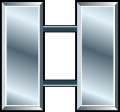 |
 |
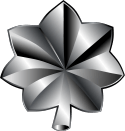 |
|
|
|
|
|
 |
 | |
| Title | Second Lieutenant |
First Lieutenant |
Captain | Major | Lieutenant Colonel |
Colonel | Brigadier General |
Major General |
Lieutenant General |
General | General of the Army |
General of the Armies of the United States | |
| Abbreviation | 2LT | 1LT | CPT | MAJ | LTC | COL | BG | MG | LTG | GEN | GA | GAS | |
| NATO Code | OF-1 | OF-2 | OF-3 | OF-4 | OF-5 | OF-6 | OF-7 | OF-8 | OF-9 | OF-10 | OF-11 | ||
| Note: General of the Army is reserved for wartime.[69] | |||||||||||||
Warrant officers
Warrant officers[67] are single track, specialty officers with subject matter expertise in a particular area. They are initially appointed as warrant officers (in the rank of WO1) by the Secretary of the Army, but receive their commission upon promotion to chief warrant officer two (CW2).
By regulation, warrant officers are addressed as 'Mr. (last name)' or 'Ms. (last name)' by senior officers, and as "sir" or "ma'am" by all enlisted personnel.[68] However, many personnel address warrant officers as 'Chief (last name)' within their units regardless of rank.
| US DoD pay grade | W-1 | W-2 | W-3 | W-4 | W-5 |
|---|---|---|---|---|---|
| Insignia | |
|
|
|
|
| Title | Warrant Officer 1 | Chief Warrant Officer 2 | Chief Warrant Officer 3 | Chief Warrant Officer 4 | Chief Warrant Officer 5 |
| Abbreviation | WO1 | CW2 | CW3 | CW4 | CW5 |
| NATO Rank | WO-1 | WO-2 | WO-3 | WO-4 | WO-5 |
Enlisted personnel
Sergeants and corporals are referred to as NCOs, short for non-commissioned officers.[67][70] This distinguishes corporals from the more numerous specialists, who have the same pay grade but do not exercise leadership responsibilities.
Privates (E1 and E2) and privates first class (E3) are addressed as 'Private (last name)', specialists as 'Specialist (last name)', corporals as 'Corporal (last name)', and sergeants, staff sergeants, sergeants first class, and master sergeants all as 'Sergeant (last name).' First sergeants are addressed as 'First Sergeant (last name)', and sergeants major and command sergeants major are addressed as 'Sergeant Major (last name)'.[68]
| US DoD Pay grade | E-1 | E-2 | E-3 | E-4 | E-5 | E-6 | E-7 | E-8 | E-9 | ||||
|---|---|---|---|---|---|---|---|---|---|---|---|---|---|
| Insignia | No Insignia | |
|
|
|
|
|
|
|
|
|
|
|
| Title | Private | Private | Private First Class |
Specialist | Corporal | Sergeant | Staff Sergeant |
Sergeant First Class |
Master Sergeant |
First Sergeant |
Sergeant Major |
Command Sergeant Major |
Sergeant Major of the Army |
| Abbreviation | PV1 ¹ | PV2 ¹ | PFC | SPC ² | CPL | SGT | SSG | SFC | MSG | 1SG | SGM | CSM | SMA |
| NATO Code | OR-1 | OR-2 | OR-3 | OR-4 | OR-4 | OR-5 | OR-6 | OR-7 | OR-8 | OR-8 | OR-9 | OR-9 | OR-9 |
| ¹ PVT is also used as an abbreviation for both private ranks when pay grade need not be distinguished.[71] ² SP4 is sometimes encountered instead of SPC for specialist. This is a holdover from when there were additional specialist ranks at pay grades E-5 to E-7. | |||||||||||||
Training

Training in the U.S. Army is generally divided into two categories – individual and collective. Basic training consists of 10 weeks for most recruits followed by Advanced Individualized Training (AIT) where they receive training for their military occupational specialties (MOS). Some individuals MOSs range anywhere from 14–20 weeks of One Station Unit Training (OSUT), which combines Basic Training and AIT. The length of AIT school varies by the MOS The length of time spent in AIT depends on the MOS of the soldier, and some highly technical MOS training may require many months (e.g., foreign language translators). Depending on the needs of the army, Basic Combat Training for combat arms soldiers is conducted at a number of locations, but two of the longest-running are the Armor School and the Infantry School, both at Fort Benning, Georgia.
Following their basic and advanced training at the individual-level, soldiers may choose to continue their training and apply for an "additional skill identifier" (ASI). The ASI allows the army to take a wide ranging MOS and focus it into a more specific MOS. For example, a combat medic, whose duties are to provide pre-hospital emergency treatment, may receive ASI training to become a cardiovascular specialist, a dialysis specialist, or even a licensed practical nurse. For commissioned officers, ASI training includes pre-commissioning training either at USMA, or via ROTC, or by completing OCS. After commissioning, officers undergo branch specific training at the Basic Officer Leaders Course, (formerly called Officer Basic Course), which varies in time and location according their future assignments. Further career development is available through the Army Correspondence Course Program.

Collective training at the unit level takes place at the unit's assigned station, but the most intensive training at higher echelons is conducted at the three combat training centers (CTC); the National Training Center (NTC) at Fort Irwin, California, the Joint Readiness Training Center (JRTC) at Fort Polk, Louisiana, and the Joint Multinational Training Center (JMRC) at the Hohenfels Training Area in Hohenfels, Germany. ARFORGEN is the Army Force Generation process approved in 2006 to meet the need to continuously replenish forces for deployment, at unit level, and for other echelons as required by the mission. Individual-level replenishment still requires training at a unit level, which is conducted at the continental US (CONUS) replacement center at Fort Bliss, in New Mexico and Texas, before their individual deployment.
Equipment
Weapons
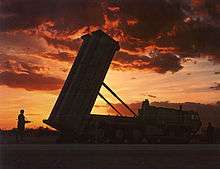
- Individual weapons
The army employs various individual weapons to provide light firepower at short ranges. The most common weapons used by the army are the compact variant of the M16 rifle, the M4 carbine,[72] as well as the 7.62×51mm variant of the FN SCAR for Army Rangers. The primary sidearm in the U.S. Army is the 9 mm M9 pistol; the M11 pistol is also used. Both handguns are to be replaced through the Modular Handgun System program.[73] Soldiers are also equipped with various hand grenades, such as the M67 fragmentation grenade and M18 smoke grenade.
Many units are supplemented with a variety of specialized weapons, including the M249 SAW (Squad Automatic Weapon), to provide suppressive fire at the fire-team level.[74] Indirect fire is provided by the M203 grenade launcher. The M1014 Joint Service Combat Shotgun or the Mossberg 590 Shotgun are used for door breaching and close-quarters combat. The M14EBR is used by designated marksmen. Snipers use the M107 Long Range Sniper Rifle, the M2010 Enhanced Sniper Rifle, and the M110 Semi-Automatic Sniper Rifle.


- Crew served weapons
The army employs various crew-served weapons to provide heavy firepower at ranges exceeding that of individual weapons.
The M240 is the US Army's standard Medium Machine Gun.[75] The M2 heavy machine gun is generally used as a vehicle-mounted machine gun. In the same way, the 40 mm MK 19 grenade machine gun is mainly used by motorized units.[76]
The US Army uses three types of mortar for indirect fire support when heavier artillery may not be appropriate or available. The smallest of these is the 60 mm M224, normally assigned at the infantry company level.[77] At the next higher echelon, infantry battalions are typically supported by a section of 81 mm M252 mortars.[78] The largest mortar in the army's inventory is the 120 mm M120/M121, usually employed by mechanized units.[79]
Fire support for light infantry units is provided by towed howitzers, including the 105 mm M119A1[80] and the 155 mm M777 (which will replace the M198).[81]
The US Army utilizes a variety of direct-fire rockets and missiles to provide infantry with an Anti-Armor Capability. The AT4 is an unguided projectile that can destroy armor and bunkers at ranges up to 500 meters. The FIM-92 Stinger is a shoulder-launched, heat seeking anti-aircraft missile. The FGM-148 Javelin and BGM-71 TOW are anti-tank guided missiles.
Vehicles
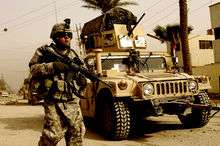
The army's most common vehicle is the High Mobility Multipurpose Wheeled Vehicle (HMMWV), commonly called the Humvee, which is capable of serving as a cargo/troop carrier, weapons platform, and ambulance, among many other roles.[82] While they operate a wide variety of combat support vehicles, one of the most common types centers on the family of HEMTT vehicles. The M1A2 Abrams is the army's main battle tank,[83] while the M2A3 Bradley is the standard infantry fighting vehicle.[84] Other vehicles include the Stryker,[85] and the M113 armored personnel carrier,[86] and multiple types of Mine Resistant Ambush Protected (MRAP) vehicles.
The Pentagon bought 25,000 MRAP vehicles since 2007 in 25 variants through rapid acquisition with no long-term plans for the platforms. The Army plans to divest 7,456 vehicles and retain 8,585. Of the total number of vehicles the Army will keep, 5,036 will be put in storage, 1,073 will be used for training, and the remainder will be spread across the active force. The Oshkosh M-ATV will be kept the most at 5,681 vehicles, as it is smaller and lighter than other MRAPs for off-road mobility. The other most retained vehicle will be the Navistar MaxxPro Dash with 2,633 vehicles, plus 301 Maxxpro ambulances. Thousands of other MRAPs like the Cougar, BAE Caiman, and larger MaxxPros will be disposed of.[87]
The U.S. Army's principal artillery weapons are the M109A6 Paladin self-propelled howitzer[88] and the M270 Multiple Launch Rocket System (MLRS),[89] both mounted on tracked platforms and assigned to heavy mechanized units.
While the United States Army Aviation Branch operates a few fixed-wing aircraft, it mainly operates several types of rotary-wing aircraft. These include the AH-64 Apache attack helicopter,[90] the OH-58D Kiowa Warrior armed reconnaissance/light attack helicopter,[91] the UH-60 Black Hawk utility tactical transport helicopter,[92] and the CH-47 Chinook heavy-lift transport helicopter.[93] Restructuring plans call for reduction of 750 aircraft and from 7 to 4 types.[94]
Under the Johnson-McConnell agreement of 1966, the Army agreed to limit its fixed-wing aviation role to administrative mission support (light unarmed aircraft which cannot operate from forward positions). For UAVs, the Army is deploying at least one company of drone MQ-1C Gray Eagles to each Active Army division.[95]
Uniforms
The Army Combat Uniform, or ACU, currently features a digital Universal Camouflage Pattern (UCP) and is designed for use in woodland, desert, and urban environments. However, soldiers operating in Afghanistan are being issued a fire-resistant ACU with the "MultiCam" pattern, officially known as Operation Enduring Freedom Camouflage Pattern or "OCP".[96]


The standard garrison service uniform is the Army Service Uniform, which functions as both a garrison uniform (when worn with a white shirt and necktie) and a dress uniform (when worn with a white shirt and either a necktie for parades or a bow tie for after six or black tie events).
Berets
The U.S. Army's black beret is no longer worn with the new ACU for garrison duty, having been permanently replaced with the patrol cap. After years of complaints that it wasn't suited well for most work conditions, Army Chief of Staff General Martin Dempsey eliminated it for wear with the ACU in June 2011. U.S. soldiers still wear berets who are currently in a unit in jump status, whether the wearer is parachute-qualified, or not (maroon beret), Members of the 75th Ranger Regiment and the Airborne and Ranger Training Brigade (tan beret), and Special Forces (rifle green beret) and may wear it with the Army Service Uniform for non-ceremonial functions. Unit commanders may still direct the wear of patrol caps in these units in training environments or motor pools.
Tents
The army has relied heavily on tents to provide the various facilities needed while on deployment. The most common tent uses for the military are as temporary barracks (sleeping quarters), DFAC buildings (dining facilities), forward operating bases (FOBs), after action review (AAR), tactical operations center (TOC), morale, welfare, and recreation (MWR) facilities, and security checkpoints. Furthermore, most of these tents are set up and operated through the support of Natick Soldier Systems Center.
The U.S. Army is beginning to use a more modern tent called the deployable rapid assembly shelter or DRASH. In 2008, DRASH became part of the Army's Standard Integrated Command Post System.[97]
Tomb of the Unknowns is a tomb that soldiers walk and salute every day in any weather.[98]
3D printing
In November 2012, the United States Army developed a tactical 3D printing capability to allow it to rapidly manufacture critical components on the battlefield.[99]
See also
- America's Army (Video games for recruitment)
- Army CHESS (Computer Hardware Enterprise Software and Solutions)
- Army National Guard
- Comparative military ranks
- History of the United States Army
- List of active United States military aircraft
- List of former United States Army medical units
- List of wars involving the United States
- Military–industrial complex
- Officer Candidate School (United States Army)
- Reserve Officers' Training Corps and Junior Reserve Officers' Training Corps
- Soldier's Creed
- Structure of the United States Army
- Timeline of United States military operations
- Transformation of the United States Army
- U.S. Army Combat Arms Regimental System
- U.S. Army Regimental System
- United States Military Academy
- United States Army Basic Training
- United States Army Center of Military History
- United States Volunteers
- Vehicle markings of the United States military
- Warrant Officer Candidate School (United States Army)
Notes and references
- ↑ Wright, Jr., Robert K. (1983). The Continental Army (Army Lineage Series). Washington, DC: Center of Military History, United States Army. ISBN 9780160019319. OCLC 8806011.
- ↑ Maass, John R. "June 14th: The Birthday of the U.S. Army". U.S. Army Center of Military History. Retrieved 30 October 2013.
- 1 2 "Department of Defense (DoD) Releases Fiscal Year 2017 President's Budget Proposal". U.S. Department of Defense. 9 February 2016. Retrieved 11 February 2016.
- ↑ Flightglobal - World Air Forces 2015 (PDF), Flightglobal.com
- ↑ Usa, Ibp. U.S. Future Combat & Weapon Systems Handbook. p. 15.
- 1 2 3 "14 June: The Birthday of the U.S. Army". United States Army Center of Military History. Retrieved 1 July 2011. an excerpt from Robert Wright, The Continental Army
- ↑ Library of Congress, Journals of the Continental Congress, Volume 27
- ↑ "Army Birthdays". United States Army Center of Military History. 15 November 2004. Archived from the original on 20 April 2010. Retrieved 3 Jun 2010.
- ↑ "The United States Army - Organization". army.mil. Retrieved 1 April 2015.
- ↑ DA Pamphlet 10-1 Organization of the United States Army; Figure 1.2 Military Operations.
- ↑ "10 USC 3062: Policy; composition; organized peace establishment". US House of Representatives. Retrieved 21 Aug 2013.
- ↑ Cont'l Cong., Formation of the Continental Army, in 2 Journals of the Continental Congress, 1774–1789 89–90 (Library of Cong. eds., 1905).
- ↑ Cont'l Cong., Commission for General Washington, in 2 Journals of the Continental Congress, 1774-1789 96-7 (Library of Cong. eds., 1905).
- ↑ Cont'l Cong., Instructions for General Washington, in 2 Journals of the Continental Congress, 1774-1789 100-1 (Library of Cong. eds., 1905).
- ↑ Cont'l Cong., Resolution Changing "United Colonies" to "United States", in 5 Journals of the Continental Congress, 1774-1789 747 (Library of Cong. eds., 1905).
- ↑ Ron Field and Richard Hook, The Seminole Wars 1818–58 (2009)
- ↑ "The U.S.-Mexican War - PBS". pbs.org. Retrieved 1 April 2015.
- ↑ Tinkler, Robert. "Southern Unionists in the Civil War". http://www.csuchico.edu/. http://www.csuchico.edu/. Retrieved November 21, 2016. External link in
|website=, |publisher=(help) - ↑ McPherson, James M., ed. The Atlas of the Civil War, (Philadelphia, PA, 2010)
- ↑ Maris Vinovskis (1990). "Toward a social history of the American Civil War: exploratory essays". Cambridge University Press. p. 7. ISBN 0-521-39559-3
- ↑ Cragg, Dan, ed., The Guide to Military Installations, Stackpole Books, Harrisburg, 1983, p. 272.
- ↑ Woodruff, Mark. Unheralded Victory: The Defeat of the Viet Cong and the North Vietnamese Army 1961–1973 (Arlington, VA: Vandamere Press, 1999).
- ↑ Wilson, John B. (1997). Maneuver and Firepower: The Evolution of Divisions and Separate Brigades. Washington, DC: Center of Military History, Chapter XII, for references see Note 48.
- ↑ Army National Guard Constitution
- ↑ Carafano, James, Total Force Policy and the Abrams Doctrine: Unfulfilled Promise, Uncertain Future, Foreign Policy Research Institute, 3 February 2005.
- ↑ An Army at War: Change in the Midst of Conflict, p. 515, via Google Books
- ↑ Section 1101, National Defense Authorization Act for Fiscal Years 1990 and 1991, Department of Defense Interim Report to Congress, September 1990. (See "rebalancing" as used in finance.)
- ↑ Downey, Chris, The Total Force Policy and Effective Force, Air War College, 19 March 2004.
- ↑ "September 11, 2001 Pentagon Victims". patriotresource.com. Retrieved 13 November 2015.
- ↑ "9/11 a day of remembrance". The Star Press. Muncie, Indiana.
- ↑ Burnham, G; Lafta, R; Doocy, S; Roberts, L (2006). John Pike, ed. "U.S. Casualties in Iraq". The Lancet. GlobalSecurity.org (published 4 September 2007). 368 (9545): 1421–1428. doi:10.1016/S0140-6736(06)69491-9. PMID 17055943. Archived from the original (web page) on 5 September 2007. Retrieved 16 January 2012.
- ↑ "The Human Cost of the War in Iraq: A Mortality Study, 2002–2006" (PDF). (603 KB). By Gilbert Burnham, Shannon Doocy, Elizabeth Dzeng, Riyadh Lafta, and Les Roberts. A supplement to the second Lancet study.
- ↑ 597 killed in 2003,, 23,984 killed from 2004 through 2009 (with the exceptions of May 2004 and March 2009), 652 killed in May 2004, 45 killed in March 2009, 676 killed in 2010, 451 killed in 2011 (with the exception of February), thus giving a total of 26,405 dead.
- ↑ "FCS Program Transitions to Army BCT Modernization". defencetalk.com. Defencetalk.com. June 26, 2009. Retrieved November 21, 2016.
- ↑ Shanker, Thom; Cooper, Helene (23 February 2014). "Pentagon Plans to Shrink Army to Pre-World War II Level". The New York Times Company. Retrieved 23 February 2014.
- ↑ Drwiega, Andrew. "Missions Solutions Summit: Army Leaders Warn of Rough Ride Ahead" Rotor&Wing, June 4, 2014. Accessed: June 8, 2014.
- ↑ DA Pam 10-1 Organization of the United States Army; Figure 1-1. '"Army Organizations Execute Specific Functions and Assigned Missions"
- ↑ Organization of the United States Army: America's Army 1775 – 1995, DA PAM 10–1. Headquarters, Department of the Army, Washington, 14 June 1994.
- 1 2 Finnegan, John Patrick; Romana Danysh (1998). "Chapter 2: World War I". In Jeffrey J. Clarke. Military Intelligence. Army Lineage Series. Washington, D.C., United States: Center of Military History, United States Army. online. ISBN 0-16-048828-1. OCLC 35741383.
- 1 2 Pullen, Randy (23 April 2008). "Army Reserve Marks First 100 Years". DefenceTalk. Archived from the original (online article) on 24 April 2008. Retrieved 8 August 2008.
- ↑ http://armypubs.army.mil/epubs/pdf/go1204.pdf
- ↑ "Commanding General" (PDF). United States Army, Surface Deployment and Distribution Command. 7 September 2010. Retrieved 26 February 2012.
- 1 2 http://www.apd.army.mil/pdffiles/go1402.pdf
- ↑ "Archived copy" (PDF). Archived from the original (PDF) on 14 May 2011. Retrieved 7 March 2011.
- ↑ U.S. Army (1 October 2010). "Army establishes Army Cyber Command". army.mil. Retrieved 28 June 2016.
- ↑ GO 2016-11 http://www.apd.army.mil/Search/ePubsSearch/ePubsSearchForm.aspx?x=DAGO
- ↑ http://www.apd.army.mil/pdffiles/go1202.pdf
- ↑ "8th Army chief vows firm readiness". Koreatimes.co.kr. 2016-02-02. Retrieved 2016-05-02.
- ↑ http://www.apd.army.mil/pdffiles/go1475.pdf
- ↑ http://www.apd.army.mil/pdffiles/go1215.pdf
- ↑ The Relationship of U. S. Army Cyber Command and Second Army, U.S. Army Cyber Command, last accessed 12 January 2015
- ↑ http://www.apd.army.mil/pdffiles/go0633.pdf
- ↑ Lieutenant General Todd T. Semonite, Biography article, undated. Retrieved 28 June 2016.
- ↑ http://www.apd.army.mil/pdffiles/go1390.pdf
- ↑ Organization, United States Army
- ↑ Perpich v. Department of Defense, 496 U.S. 334 (1990)
- ↑ "10 U.S.C. 3013" (PDF). Retrieved 2016-05-02.
- ↑ "10 U.S.C. 3033" (PDF). Retrieved 2016-05-02.
- ↑ "10 U.S.C. 151" (PDF). Retrieved 2016-05-02.
- ↑ "10 U.S.C. 162" (PDF). Retrieved 2016-05-02.
- ↑ "CSA Odierno and SMA Chandler virtual town hall, Jan 6, 2015". Army.mil. Retrieved 2016-05-02.
- ↑ "First Army - Mission". army.mil. Retrieved 1 April 2015.
- ↑ http://www.apd.army.mil/pdffiles/go1102.pdf
- ↑ Army announces Afghanistan deployment for 1,000 soldiers, ArmyTimes, by Michelle Tan, dated 2 March 2016, last accessed 3 October 2016
- ↑ "South Korean troops form combined division with U.S. Army". Army Times. 14 January 2015. Retrieved 13 November 2015.
- 1 2 USASOC Headquarters Fact Sheet, from the USASOC official website, last accessed 8 October 2016
- 1 2 3 From the Future Soldiers Web Site.
- 1 2 3 "Army Regulation 600-20" (PDF). Retrieved 2016-05-02.
- ↑ "Department of Defense - Officer Rank Insignia". defense.gov. Retrieved 1 April 2015.
- ↑ From the Enlisted Soldiers Descriptions Web Site.
- ↑ http://www.apd.army.mil/pdffiles/r600_20.pdf
- ↑ M4. U.S. Army Fact Files
- ↑ Individual Weapons Future Innovations, Project Manager Soldier Weapons.
- ↑ M249, U.S. Army Fact Files
- ↑ M240, U.S. Army Fact Files
- ↑ MK 19, U.S. Army Fact Files
- ↑ M224, U.S. Army Fact Files
- ↑ M252, U.S. Army Fact Files
- ↑ M120, U.S. Army Fact Files
- ↑ M119, U.S. Army Fact Files
- ↑ John Pike. "M777 Lightweight 155mm howitzer (LW155)". globalsecurity.org. Retrieved 1 April 2015.
- ↑ HMMWV, U.S. Army Fact Files
- ↑ Abrams, U.S. Army Fact Files
- ↑ Bradley, United States Army Fact Files
- ↑ Stryker, U.S. Army Fact Files
- ↑ M113, U.S. Army Fact Files
- ↑ "Majority of MRAPs to be scrapped or stored", Military Times, 5 January 2014
- ↑ Paladin, Army.mil
- ↑ MLRS, U.S. Army Fact Files
- ↑ Apache, U.S. Army Fact Files
- ↑ Kiowa, U.S. Army Fact Files
- ↑ Blackhawk, U.S. Army Fact Files
- ↑ Chinook, U.S. Army Fact Files
- ↑ Stevenson, Beth (22 January 2015), "US Army continues to face financial challenge of rotary fleet maintenance", Flightglobal, Reed Business Information, archived from the original on 23 January 2015, retrieved 23 January 2015
- ↑ Kyle Jahner, Army Times (3:35 p.m. EST January 8, 2015) "Army to build dedicated drone runway at Fort Bliss"
- ↑ Lopez, C. (20 February 2010). "Soldiers to get new cammo pattern for wear in Afghanistan". US Army. Retrieved 22 February 2010.
- ↑ NG, DHS Technologies to support SICPS/TMSS United Press International
- ↑ http://www.arlingtoncemetery.mil/Explore/Tomb-of-the-Unknown-Soldier
- ↑ "US army builds its own 3D printer". BBC News.
-
 This article incorporates public domain material from the United States Army Center of Military History document "Army Birthdays".
This article incorporates public domain material from the United States Army Center of Military History document "Army Birthdays".
Further reading
- Bailey, Beth. America's Army: Making the All-Volunteer Force (2009) excerpt
- Bluhm, Jr,, Raymond K. (Editor-in-Chief); Andrade, Dale; Jacobs, Bruce; Langellier, John; Newell, Clayton R.; Seelinger, Matthew (2004). U.S. Army: A Complete History (Beaux Arts ed.). Arlington, VA: The Army Historical Foundation. p. 744. ISBN 978-0-88363-640-4.
- Kretchik, Walter E. U.S. Army Doctrine: From the American Revolution to the War on Terror (University Press of Kansas; 2011) 392 pages; studies military doctrine in four distinct eras: 1779–1904, 1905–1944, 1944–1962, and 1962 to the present.
- Woodward, David R. The American Army and the First World War (Cambridge University Press, 2014). 484 pp. online review
External links
- Army.mil – United States Army official website
- GoArmy.com – official recruiting site
- U.S. Army Collection – Missouri History Museum
- Finding Aids for researching the US Army (compiled by the United States Army Center of Military History)
- US-militaria.com – The US Army during the Second World War
